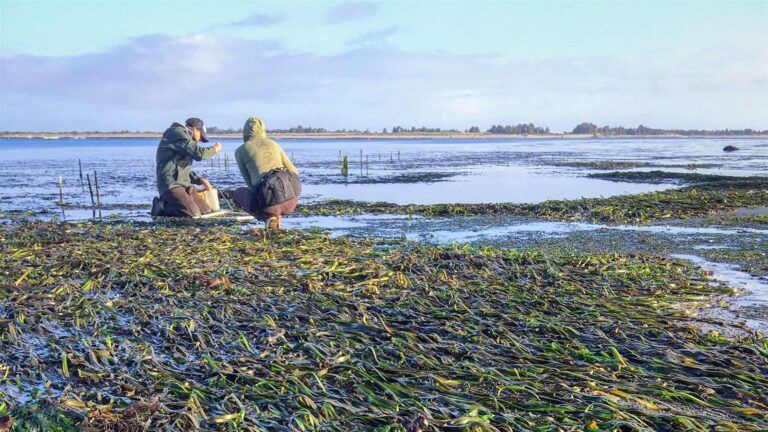Photo: Scientists sample eelgrass in the South Slough, in Charleston, Oregon, along the state’s south coast. This flowering marine plant is an essential ally in reducing the effects of climate change. The Pew Charitable Trusts
As West Coast states look to develop and implement plans that make coastal communities more climate resilient, policymakers should look to eelgrass meadows and other tidal wetland habitats to play a critical role in that effort. These habitats capture and store carbon, filter excess nutrients from the water, produce oxygen, and help protect coastal communities from floods and storm surge. Healthy eelgrass meadows also provide vital habitat for salmon, Dungeness crab, and other wildlife that are important to the region’s economy.
Marine scientists Melissa Ward and Kathryn Beheshti recently published a first-of-its-kind analysis of eelgrass restoration and mitigation projects that offers important lessons and recommendations for natural resource managers. The study, which is publicly available in Ecosphere, a journal of the Ecological Society of America, examined 82 West Coast restoration projects spanning 30 years. Here are some key takeaways from their research.
Mitigation is an uncertain, risky prospect for the climate.
Natural resource managers often seek to offset, or mitigate, the potential environmental damage from a project—for example, building a dock or dredging—by protecting or restoring another area. Managers of eelgrass and other wetland areas often do this to comply with state or federal laws requiring “no net loss” or a “net gain” in the size of those habitats.
But this trade-off doesn’t often succeed in replacing lost benefits to people and nature. Ward and Beheshti’s work shows that the gains from such an approach are, at best, an uncertain substitute for what is damaged. Their research found that 32.3% to 59.6% of restoration efforts failed to achieve the stated conservation goals of the project. These results underscore why Pew advocates for avoiding damage in the first place, enacting new protections and—where feasible—helping to restore degraded coastal wetlands and eelgrass.
However, attempting to mitigate damage to eelgrass meadows also carries climate risks. Healthy eelgrass beds store high quantities of […]
Full article: www.pewtrusts.org

